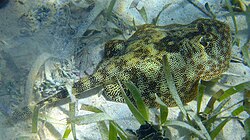イエロースティングレイ
„ǧ„Ç®„É≠„ɺ„Çπ„ÉÜ„Ç£„É≥„Ç∞„ɨ„ǧԺàUrobatis jamaicensisÔºâ„ÅØ„ÄÅ„Éà„Éì„Ç®„ǧÁõƄǶ„É≠„Éà„É™„Ç¥„É≥Áßë„ÅƉ∏ÄÁ®Æ„ÄÇ„Éé„ɺ„Çπ„Ç´„É≠„É©„ǧ„ÉäÂ∑û„Åã„Çâ„Éà„É™„Éã„ÉĄɺ„ÉâÂ≥∂„Åæ„Åß„ÅÆË•øÈɮ§ßË•øÊ¥ã„ÅÆÁܱÂ∏ØÂüü„ÅÆÊ≤øÂ≤∏ÈÉ®„Å´ÂàÜÂ∏É„Åô„Çã„ÄDŽǵ„É≥„Ç¥Á§Å‰ªòËøë„ÅÆʵքÅÑÁÝÇÊ≥•Â∫ï„ÄÅËóªÂÝ¥„Å´ÁîüÊÅØ„Åô„ÇãÂ∫ïÈ≠ö„Åß„ÅÇ„Çã„ÄljΩìÁõ§ÂπÖ„ÅØ36cm‰ª•‰∏ã„Åß„ÄÅÂÜÜÂΩ¢„ÅƉΩìÁõ§„Å®Áü≠„ÅÑÂ∞æ„ÄÅÁô∫ÈÅî„Åó„ÅüÂ∞æÈ∞≠„ÅåÁâπÂ楄ÄÇËÉåÈù¢„ÅØÊòéËâ≤„Åß„ÄÅÊöóËâ≤„ÅÆÁ∂≤ÁõÆÊ®°Êßò„ÅåÂÖ•„Çä„ÄÅÂÖ®‰ΩìÁöÑ„Å´ÊñëÊ®°Êßò„Å´„Å™„Å£„Ŷ„ÅÑ„Çã„ÄljΩìËâ≤„ÇíÊÄ•ÈÄü„Ŵ§âÂåñ„Åï„Åõ„ÄÅʵ∑Â∫ï„Å´Êì¨ÊÖã„Åô„Çã„ÄÇ Êó•‰∏≠„ÅØ„ÅÇ„Åæ„ÇäÈÅäÊ≥≥„Åõ„Åö„ÄÅÂ∞èÂûã„ÅÆÁÑ°ËÑäʧéÂãïÁâ©„ÇÑÁ°¨È™®È≠öÈ°û„ÇíÊçïÈ£ü„Åô„Çã„ÄÇÈ∞≠„ÇíÊ≥¢Êâì„Åü„Åõʵ∑Â∫ï„Å´Âüã„Åæ„Å£„ÅüÁç≤Áâ©„ÇíÊéò„ÇäÂá∫„Åó„Åü„Çä„ÄʼnΩìÁõ§„ÇíÊåÅ„Å°‰∏ä„Åí„ŶÂΩ±„Çí‰Ωú„Çä„ÄÅÁâ©Èô∞„ÇíÂ•Ω„ÇÄÁîüÁâ©„Çí„Åä„Å≥„ÅçÂØÑ„Åõ„Åü„Çä„Åô„Çã„ÄÇÁÑ°ËÉéÁõ§ÊÄß„ÅÆËÉéÁîü„Åß„ÅÇ„Çä„ÄÅËÉö„ÅØÊúÄÂàù„ÅØÂçµÈªÑ„Å´„Çà„Å£„Ŷ„ÄÅÂæå„Å´Â≠êÂÆÆÂàÜÊ≥åÊ∂≤„Å´„Çà„Å£„ŶÁ∂≠ÊåÅ„Åï„Çå„Çã„ÄÇÈõå„ÅØ5-6„ÅãÊúà„Åƶä®ÝÊúüÈñì„ÇíÁµå„Ŷ„ÄÅËóªÂÝ¥„ÅßÂπ¥„Å´2Âõû„ÄÅÊúħß7Â∞æ„ÅƉªî„Ç®„ǧ„ÇíÂá∫ÁÅô„Çã„ÄÇ ‰∫∫Èñì„Å´„ÅØÁÑ°ÂÆ≥„ÅÝ„Åå„ÄÅÂ∞æÊ£ò„Å´Âà∫„Åï„Çå„Çã„Å®ÊÄ™Êàë„ÇíË≤Ý„ÅÜÊÅê„Çå„Åå„ÅÇ„Çã„ÄÇÁîüÊÅØÂú∞„ÅÆÁí∞¢ÉÊÇ™Âåñ„Å´„Çà„ÇäÊÇ™ÂΩ±Èüø„ÇíÂèó„Åë„Ŷ„ÅÑ„ÇãÂèØËÉΩÊÄß„Åå„ÅÇ„Çä„ÄÅÂïÜÊ•≠ʺÅÊ•≠„Åß„ÅÆÊ∑∑Áç≤„ÄÅ˶≥Ë≥ûÁõÆÁöÑ„ÅÆÊçïÁç≤„ÅåÂ∫ÉÁØÑÂõ≤„Å߉∏ÄËà¨ÁöфŴ˵∑„Åì„Å£„Ŷ„ÅÑ„Çã„Åü„ÇÅ„ÄÅÂõΩÈöõËá™ÁÑ∂‰øùË≠∑ÈÄ£Âêà(IUCN)„ÅØÊú¨Á®Æ„Çí‰ΩéÂç±Èô∫Á®Æ„Å®„Åó„Ŷ„ÅÑ„Çã„ÄÇ ÂàÜÈ°û„Å®Á≥ªÁµ±„Éï„É©„É≥„Çπ„ÅÆÂçöÁâ©Â≠¶ËÄÖ„Ç∏„Éß„É´„Ç∏„É•„ɪ„Ç≠„É•„É¥„Ç£„Ç®„ÅØ1816Âπ¥„Å´„ÄÅ„ÄéLe R√®gne Animal distribu√© d'apr√®s Son Organization pour servir de Base √Ý l'histoire Naturelle des animaux et d'introduction √Ý l'anaomie compar√©e„Äè„ÅƉ∏≠„ÅßÊú¨Á®Æ„Çí Raia jamaicensis „Å®„Åó„Ŷˮò˺â„Åó„Åü„ÄÇÂΩº„ÅØ„Ç∏„É£„Éû„ǧ„Ç´„Åã„ÇâÂÖ•Êâã„Åó„ÅüÊ®ôÊú¨„Å´Âü∫„Å•„ÅфŶ˙¨Êòé„ÇíË°å„Å£„Åü„Åå„ÄÅÊ®°ÂºèÊ®ôÊú¨„ÅØÊåáÂÆö„Åï„Çå„Ŷ„ÅÑ„Å™„Åã„Å£„Åü[2]„ÄÇ„Åù„ÅÆÂæå„Éí„É©„Çø„Ç®„ǧ±û„Å®„Åï„Çå„ÄÅ„Åï„Çâ„Å´ Urobatis ±û„Å®„Å™„Å£„Åü„ÄÇyellow-spotted ray„ÄÅround ray„ÄÅmaid ray„Å™„Å©„ÅÆÂà•Âêç„Åå„ÅÇ„Çã[3]„ÄÇ Nathan Lovejoy„Å´„Çà„Çã1996Âπ¥„ÅÆÂΩ¢ÊÖãÂ≠¶„Å´Âü∫„Å•„ÅèÁ≥ªÁµ±ËߣÊûê„Åß„ÅØ„ÄÅÊú¨Á®Æ„Åا™Âπ≥Ê¥ã„ÅÆ Urotrygon ±û„Å®Âçó„Ç¢„É°„É™„Ç´„ÅÆ Urobatis ±û„ÇíÂê´„ÇÄ„Ç؄ɨ„ɺ„Éâ„Åß„ÅØÊúÄ„ÇÇÂü∫ÈÉ®„ÅÆÁ®Æ„Åß„ÅÇ„Çã„Å®„Åï„Çå„Åü„ÄÇUrobatis ±û„ÅاöÁ≥ªÁµ±Á槄Ů„ÅÑ„ÅÜ„Åì„Å®„Å´„Å™„Çã„Åå„ÄÅ„Åì„Çå„Çâ„ÅÆÂàÜÈ°ûÁæ§Èñì„ÅÆÈñ¢‰øÇ„ÇíËߣÊòé„Åô„Çã„Å´„ÅØ„Åï„Çâ„Å™„ÇãÁÝîÁ©∂„ÅåÂøÖ˶ńÅß„ÅÇ„Çã[4]„ÄÇ ÂΩ¢ÊÖã ‰ΩìÁõ§ÂπÖ36cm„ÄÅÂÖ®Èï∑70cm„ÅÆÂ∞èÂûãÁ®Æ„Åß„ÅÇ„Çã[1][5]„ÄljΩìÁõ§„ÅØÂÉÖ„Åã„Å´Á∏¶Èï∑„ÅÆÂÜÜÂΩ¢„Åß„ÄÅÂêªÈÉ®„ÅØÁü≠„ÅèÈàç„ÅÑ„ÄÇÁúº„ÅÆÂæåÊñπ„Å´Âô¥Ê∞¥Â≠î„Åå„ÅÇ„Çã„ÄÇȺªÂ≠î„ÅÆÈñì„Å´„ÅØȺªË§∂„Åå„ÅÇ„Çä„ÄÅÂæåÁ∏Å„Å´„ÅØȺªÂºÅ„Åå„ÅÇ„Çã[6]„ÄÇÂ裄ÅØÁõ¥Á∑ö‰∏ä„Åß„ÄÅÂè£Â∫ï„Å´„ÅØ3-5ÂÄã„ÅƉπ≥ÈÝ≠Áä∂Á™Å˵∑„ÅåÊ®™„Å´‰∏¶„Å∂„Älj∏ä‰∏ã„ÅÆÈ°é„ÅßÊ≠ØÂàó„ÅØ34„ÄÇÊ≠Ø„ÅØÂü∫ÈÉ®„ÅåÂ∫É„Åè„ÄÅÊàê‰ΩìÈõå„Å®Âπº‰Ωì„ÅÆÊ≠Ø„ÅØÂ∞è„Åï„ÅèÈàç„Åè„ÄÅÊàê‰ΩìÈõÑ„ÅÆÊ≠Ø„ÅØÈï∑„ÅèÂ∞ñ„Å£„Ŷ„ÅÑ„Çã„ÄÇÈõÑ„ÅØÈõå„Å´ÊØî„Åπ„ŶÊ≠Ø„ÅÆÈñìÈöî„ÅåÂ∫É„ÅÑ„ÄÇËÖπÈ∞≠ÂâçÁ∏Å„ÅØÁõ¥Á∑ö‰∏ä„Åß„ÄÅÂæåÁ∏Å„Å؉∏∏„ÅÑ[3][7]„ÄÇ Â∞æ„ÅØÂπ≥„Åü„ÅèÈÝë‰∏à„Åß„ÄÅÈï∑„Åï„ÅØÂÖ®Èï∑„ÅÆÂçäÂàÜÊú™Ê∫Ä„ÄÇÈ´ò„Åï„ÅåÊ®™ÂπÖ„ÅÆÁ¥Ñ4ÂàÜ„ÅÆ1„ÅÆÂ∞èËëâÁä∂„ÅÆÂ∞æÈ∞≠„Åå„ÅÇ„Çä„ÄÅÊúÄÂæå„ÅÆʧéÈ™®„ÅÆÂ뮄Çä„ÅßÈÄ£Á∂ö„Åó„Ŷ„ÅÑ„Çã[6][7]„ÄÇÈã∏Ê≠ØÁä∂„ÅÆÊ£ò„ÅåÂ∞æ„ÅÆÂçäÂàÜÁ®ã„ÅƉΩçÁΩÆ„Å´„ÅÇ„Çã[8]„ÄÇÁîü„Åæ„Çå„Åü„Å∞„Åã„Çä„ÅƉªî„Ç®„ǧ„ÅƉΩìË°®„ÅØʪë„Çâ„Åã„ÅÝ„Åå„ÄÅ„Åù„ÅÆÂæåÂ∞è„Åï„Å™Èàç„ÅÑÁ™Å˵∑„ÅåÊ≠£‰∏≠Á∑ö„Å´Ê≤ø„Å£„ŶÁèæ„Çå„ÄÅÊàê‰Ωì„ÅØÁõÆ„ÅÆÈñì„ÄÅÊ≠£‰∏≠Á∑ö„ÅƉ∏°ËÑá„ÄÅÂ∞æ„ÅƉªò„ÅëÊÝπ„Å´„ÇÇÁ™Å˵∑„Åå„ÅÇ„Çã„ÄÇÊàê‰Ωì„ÅØÂ∞æÈ∞≠„ÅƉ∏äÁ∏Å„Å´Ê≤ø„Å£„ŶÂèç„ÇäËøî„Å£„ÅüÊ£ò„ÅåÁô∫ÈÅî„Åô„Çã[3]„ÄljΩìËâ≤„ÇÑÊ®°Êßò„ÅØÂÄã‰ΩìÂ∑Æ„Åå§߄Åç„ÅÑ„Åå„ÄÅÂü∫Êú¨ÁöÑ„Å´ËÉåÈù¢„ÅØÊòé„Çã„ÅщΩìËâ≤„Å´Á¥∞„Åã„ÅèÊøÉ„ÅÑÁ∑ëËâ≤„Åæ„Åü„ÅØËå∂Ëâ≤„ÅÆÁ∂≤ÁõÆÊ®°Êßò„ÄÅËã•„Åó„Åè„ÅØÊøÉ„ÅÑÁ∑ëËâ≤„Åæ„Åü„ÅØËå∂Ëâ≤„ÅƉΩìËâ≤„Å´ÊøÉ„ÅÑÁôΩ„ÄÅȪÑËâ≤„ÄÅÈáëËâ≤„ÅÆÊñëÁÇπÊ®°Êßò„ÄÇËÖπÈù¢„ÅØȪÑËâ≤„Åå„Åã„Å£„Åü„ÄÅÁ∑ë„Åå„Åã„Å£„Åü„ÄÅ„Åæ„Åü„ÅØËå∂Ëâ≤„Åå„Åã„Å£„ÅüÁôΩ„Åß„ÄʼnΩìÁõ§Á∏Å„Å®Â∞扪òËøë„Å´Â∞è„Åï„Å™Êöó„ÅÑÊñëÁÇπ„ÅåÂÖ•„Çã[7]„ÄÇÁí∞¢ɄŴÂêà„Çè„Åõ„Ŷ‰ΩìËâ≤„ÅÆËâ≤Ë™ø„Å®„Ç≥„É≥„Éà„É©„Çπ„Éà„ÇíÊÄ•ÈÄü„Ŵ§â„Åà„Çâ„Çå„Çã[8]„ÄÇ ÂàÜÂ∏É„Å®ÁîüÊÅØÂú∞ „É°„Ç≠„Ç∑„Ç≥Êπæ„ÄÅ„Éï„É≠„É™„ÉÄÂ∑û„ÄÅ„Éê„Éè„Éû„Äŧ߄Ǣ„É≥„ÉÜ„Ç£„É´Ë´∏Â≥∂„Åä„Çà„Å≥Â∞è„Ç¢„É≥„ÉÜ„Ç£„É´Ë´∏Â≥∂„Åã„Çâ„Éà„É™„Éã„ÉĄɺ„ÉâÂ≥∂„Å´Ëá≥„Çã„Ç´„É™„Éñʵ∑„ÅÆÊ≤øÂ≤∏ÈÉ®„Å´ÂàÜÂ∏É„Åô„Çã[9]„ÄÇ„Åæ„Çå„Å´„ÄÅÂåó„ÅØ„Éé„ɺ„Çπ„Ç´„É≠„É©„ǧ„ÉäÂ∑û„ÅƄDZ„ɺ„Éó„ɪ„É´„ÉÉ„ÇØ„Ç¢„Ƕ„Éà(Ëã±Ë™ûÁâà)„Åæ„Åß˶ã„Çâ„Çå„Çã[7][10]„ÄÇ„Éï„É≠„É™„ÉÄ„Ç≠„ɺ„Ç∫„Å®„Ç¢„É≥„ÉÜ„Ç£„É´Ë´∏Â≥∂„ÅƉ∏ÄÈÉ®„Åß„ÅØÈùûÂ∏∏„Ŵ§ö„Åè„Äʼnªñ„ÅÆÂÝ¥ÊâÄ„Åß„ÅØ„Åã„Å™„ÇäÁ®Ä„Åß„ÅÇ„Çã„ÄÇ„É°„Ç≠„Ç∑„Ç≥Ê≤ñ„Åß„ÅØ26-40ppt„ÅÆ°©ÂàÜÊøÉÂ∫¶ÁØÑÂõ≤„Å´ÁîüÊÅØ„Åô„Çã[1]„ÄÇ Â∫ïÈ≠ö„Åß„ÅÇ„Çä„ÄÅÊπæ„ÄÅ„É©„Ç∞„ɺ„É≥„ÄÅÊ≤≥Â裄ÄÅÊ≥¢„ÅÆÂ∞ë„Å™„ÅÑÊ≤øÂ≤∏ÈÉ®„Å´ÁîüÊÅØ„Åó„Ŷ„Åä„Çä„ÄÅʵÖÁĨ„Åã„ÇâÊ∞¥Ê∑±25m„Åæ„Åß˶ã„Çâ„Çå„Çã„ÄÇÂõ∫ÁùÄÊÄß„ÅÆÁÑ°ËÑäʧéÂãïÁâ©„ÅåÂØÜÈõÜ„Åó„ÅüÂ≥∂Áä∂„ÅÆÂõ∫„ÅÑÂ∫ï„ÇíÂ•Ω„ÇÄ„Åå„ÄÅ ÁÝÇ„ÄÅÊ≥•„ÄÅ„É™„É•„Ƕ„Ç≠„É•„Ƕ„Çπ„Ǩ„ɢ±û„Å™„Å©„ÅÆʵ∑Ëçâ„ÅƉ∏ä„ÄÅÊôÇ„Å´„Å؄ǵ„É≥„Ç¥Á§Å„ÅÆËøë„Åè„Åß„ÇÇ˶ã„Çâ„Çå„Çã[1]„ÄÇ„Ç∏„É£„Éû„ǧ„Ç´Ê≤ñ„Åß„ÅØ„ÄÅ„Ç¢„Éû„ǵ„ÇÆ„Åå„Å≠„Åê„Çâ„Å®„Åó„Ŷ‰ΩøÁÅô„Çã„Éû„É≥„Ç∞„É≠„ɺ„Éñ„ÅÆÊú®„ÅƉ∏ã„Å´„ÄÅÊúħ߄Åß1„é°„ÅÇ„Åü„Çä1Âåπ„Å®„ÅÑ„ÅÜÂØÜÂ∫¶„Åß„ÄŧöÊï∞„ÅÆÂÄã‰Ωì„ÅåÈõÜ„Åæ„Çã„ÄÇÈ≥•„ÅÆÁ≥û„Å´„Çà„Å£„Ŷºï„ÅçÂØÑ„Åõ„Çâ„Çå„ÅüÁÑ°ËÑäʧéÂãïÁâ©„ÇíÁãô„ÅÜ„Åü„ÇÅ„Å®„Åï„Çå„Ŷ„ÅÑ„Çã[11]„ÄÇÂ≠£ÁØÄ„Å´„Çà„ÇãÁߪÂãï„ÅÆË®ºÊãÝ„ÅØÁÑ°„ÅÑ„Åå„ÄÅÊò•„Å´„ÅØÈõå„ÅåÈõÑ„Çà„Çä„ÇÇÂ≤∏„Å´Ëøë„ÅÑÂÝ¥ÊâÄ„Åß˶ã„ŧ„Åã„ÇãÂÇæÂêë„Åå„ÅÇ„Çã[5]„ÄÇ ÁîüÊÖã Êó•‰∏≠„ÅØ„ÅÇ„Åæ„ÇäÊ¥ªÂãïÁöÑ„Åß„ÅØ„Å™„Åè„ÄÅʵ∑Â∫ï„Å´Âüã„ÇÇ„Çå„Åü„Çä„ÄÅʵ∑Ëóª„ÅƉ∏≠„ÅßÂãï„Åã„Åö„Å´Ê®™„Åü„Çè„Å£„ŶÈÅé„Åî„Åó„Ŷ„ÅÑ„Çã[12]„ÄÇËøΩË∑°Ë™øÊüª„Å´„Çà„Çã„Å®„ÄÅË°åÂãïÁØÑÂõ≤„ÅØÈÄöÂ∏∏20,000„é°Á®ã„Å®Â∞è„Åï„Åè„Äŧö„Åè„ÅØ„Åù„ÅƉ∏ÄÈÉ®„Åß„Åó„ÅãÈÅé„Åî„Åï„Å™„ÅÑ„ÄÇÁÝÇÂú∞„Å®Â≤©Á§Å„ÅÆʺ∏ÁߪÂú∞Â∏Ø„Å™„Å©„ÄÅÁï∞„Å™„ÇãÁí∞¢ɄÅÆ¢ÉÁïå„ÇíÂ•Ω„ÇÄ[5]„ÄÇÊΩúÊúõÈè°„ÅÆ„Çà„ÅÜ„Å™Áúº„Å´„Çà„Çä„ÄÅÂë®Âõ≤„Çí360Â∫¶Ë¶ãÊ∏°„Åõ„Çã„ÄÇ„Åù„Çå„Åû„Çå„ÅÆÁúº„Å´„ÅØ„ÄÅÁû≥Â≠î„Å´ÂÖ•„ÇãÂÖâ„ÅÆÈáè„ÇíÁ¥∞„Åã„ÅèÂà∂Âæ°„Åß„Åç„ÇãËìã„Åå„ÅÇ„Çã[13]„ÄÇ„Åì„Çå„Å´„Çà„Çä„Äńǧ„Çø„ÉÅ„Ç∂„É°„Å™„Å©„ÅÆÊçïÈ£üËÄÖ„Çí„Åô„Åê„Å´Áô∫˶ã„Åß„Åç„Çã[3]„ÄÇ300-600Hz„ÅÆÈü≥„Å´ÊúÄ„ÇÇÊïèÊÑü„Åß„ÄÅ„Åì„Çå„Åæ„Åß„Å´Ë™øÊüª„Åï„Çå„ÅüÊùøÈ∞ìÈ°û„ÅƉ∏≠„Åß„ÅØÂÖ∏ÂûãÁöÑ„Åß„ÅÇ„Çã[14]„ÄÇËÑ≥„Å؉ΩìÈáç„ÅÆ1-2ÔºÖ„ÇíÂçÝ„ÇÅ„Äʼnªñ„ÅÆ„Ç®„ǧ„Å®ÊØî˺ɄÅó„Ŷ§߄Åç„ÅÑ[15]„ÄÇ È£üÊÄß„Å´„ŧ„ÅфŶ„ÅÆË®òÈå≤„ÅØÂ∞ë„Å™„ÅÑ„Åå„ÄÅ„Ç®„Éì„ÄÅËÝïËô´„Äʼn∫åÊûöË≤ù„ÄÅÂ∞èÂûã„ÅÆÁ°¨È™®È≠öÈ°û„ÇíÊçïÈ£ü„Åô„Çã„Å®„Åï„Çå„Ŷ„ÅÑ„Çã[16][17]„ÄÇÁç≤Áâ©„ÅƉ∏ä„Åã„Çâ˶܄ÅÑ„Åã„Å∂„Åï„Çä„ÄʼnΩìÁõ§„ÇíÂãï„Åã„Åó„ŶÂ裄Å∏ÈÅã„Å∂[18]„ÄÇËøëÁ∏Å„ÅÆUrobatis halleri„Å®ÂêåÊßò„Å´„ÄÅÈ∞≠„ÇíÊ≥¢Êâì„Åü„Åõ„ŶÁ©¥„ÇíÊéò„Çä„ÄÅʵ∑Â∫ï„Å´Âüã„Åæ„Å£„ÅüÁç≤Áâ©„ÇíÊéò„ÇäÂá∫„ÅôË°åÂãï„ÅåÁü•„Çâ„Çå„Ŷ„ÅÑ„Çã[3][9]„ÄÇÁâ©Èô∞„ÇíÂ•Ω„ÇÄÁîüÁâ©„Çí„Åä„Å≥„ÅçÂØÑ„Åõ„Çã„Åü„ÇÅ„Å´„ÄʼnΩì„ÅÆÂâçÈÉ®„ÇíÊåÅ„Å°‰∏ä„Åí„ŶÂΩ±„Çí‰Ωú„ÇãÊßòÂ≠ê„ÇÇ˶≥ÂØü„Åï„Çå„Ŷ„ÅÑ„Çã[16]„ÄÇÊú¨Á®Æ„ÅÆÂØÑÁîüËô´„Å´„ÅØ„ÄŧöÁØÄÊù°Ëô´‰∫úÁ∂±„ÅÆ Acanthobothrium cartagensis„ÄÅPhyllobothrium kingae„ÄÅDiscobothrium caribbensis„ÄÅRhinebothrium magniphalum[3]„ÄÅ„Åä„Çà„Å≥R. biorchidum[19]„ÄÅÂçòÁîüÁ∂±„ÅÆ Dendromonocotyle octodiscus[20]„ÅåÁü•„Çâ„Çå„Ŷ„ÅÑ„Çã„ÄÇ ÁîüÁâ©Áô∫ÂÖâ„ÇíÁ§∫„Åó„ÄÅÈùíËâ≤ÂÖâ„Åæ„Åü„ÅØÁ¥´Â§ñÁ∑ö„ÅßÁÖß„Çâ„Åï„Çå„Çã„Å®Á∑ëËâ≤„Å´Áô∫ÂÖâ„Åó„ÄÅÁôΩËâ≤ÂÖâ„ÅƉ∏ã„Å®„ÅØÁï∞„Å™„Å£„Ŷ˶ã„Åà„Çã„ÄÇÁô∫ÂÖâ„ÅØÁ®ÆÂÜÖ„ÅÆ„Ç≥„Éü„É•„Éã„DZ„ɺ„Ç∑„Éß„É≥„ÇÑ„Ç´„É¢„Éï„É©„ɺ„Ç∏„É•„Å´ÂΩπÁ´ã„Å£„Ŷ„ÅÑ„ÇãÂèØËÉΩÊÄß„Åå„ÅÇ„Çã[21]„ÄÇ ÁîüÊÆñ ÁÑ°ËÉéÁõ§ÊÄß„ÅÆËÉéÁîü„Åß„ÄÅËÉö„ÅØÊúÄÂàù„ÅØÂçµÈªÑ„Å´„Çà„Å£„ŶÁ∂≠ÊåÅ„Åï„Çå„ÄÅ„Åù„ÅÆÂæåÂ≠êÂÆƉ∏äÁöÆ„ÅÆÊÝÑȧäÂ≠êÂÆÆÁµ®ÊØõÁ≥∏„Åã„ÇâÈÄÅ„Çâ„Çå„ÇãÂ≠êÂÆÆÂàÜÊ≥åÊ∂≤„Å´„Çà„Å£„ŶÊàêÈï∑„Åô„Çã[22][23]„ÄÇÊÄßÊàêÁÜü„Åó„ÅüÂÄã‰Ωì„ÅØÊ©üËÉΩ„Åô„ÇãÂ≠êÂÆÆ„Åå2„ŧ„ÅÇ„Çä„ÄÅÂ∑¶ÂÅ¥„ÅåÂè≥ÂÅ¥„Çà„Çä„Çǧö„Åè‰ΩøÁÅï„Çå„Çã„Äǧö„Åè„ÅÆÂÝ¥ÂêàÂ∑¶„ÅÆÂçµÂ∑£„ÅÆ„Åø„ÅåÊ©üËÉΩ„Åô„Çã„ÄÇÁîüÊÆñÂë®Êúü„ÅØÂπ¥2Âõû„Åß„ÄÅÊúÄÂàù„ÅÆÊéíÂçµÊúü„ÅØ1-4Êúà„Åß„ÄÅ2Êúà‰∏ãÊó¨„Åã„Çâ3Êúà‰∏äÊó¨„Å´„Éî„ɺ„ÇØ„Å´ÈÅî„Åô„Çã„ÄÇ5-6„É∂Êúà„Åƶä®ÝÊúüÈñì„ÇíÁµå„Ŷ6-9Êúà„Å´Âá∫ÁÅó„ÄÅ7Êúà‰∏ãÊó¨„Åã„Çâ8Êúà‰∏äÊó¨„Åå„Éî„ɺ„ÇØ„Åß„ÅÇ„Çã„ÄÇ2ÂõûÁõÆ„ÅÆÊéíÂ組ÅØ8-9Êúà„Ŵ˵∑„Åì„Çä„ÄÅ11-1Êúà„Å´Âá∫ÁÅô„Çã„ÄÇÈõå„Åƶä®݉∏≠„Å´ÂçµÈªÑ„ÅÆÂΩ¢Êàê„ÅåÂßã„Åæ„Çã„Åü„ÇÅ„ÄÅ2„ŧ„ÅÆÂë®Êúü„ÅØÈáç˧á„Åô„Çã[22]„ÄÇ ‰∫§Â∞æ„ÅÆÈöõ„ÅØ1ÈÝ≠„Åæ„Åü„ÅØ˧áÊï∞„ÅÆÈõÑ„ÅåÈõå„ÇíËøΩ„ÅÑ„Åã„Åë„ŶÊ≥≥„Åé„ÄʼnΩìÁõ§„ÅÆÂæåÁ∏Å„ÇíÂôõ„Çì„ÅßÊ饄ÇÇ„ÅÜ„Å®„Åô„Çã„ÄÇÈõÑ„ÅÆÈï∑„ÅèÂ∞ñ„Å£„ÅüÊ≠Ø„ÅØ„ÄÅ„Åì„ÅÆÈöõ„Å´ÂΩπÁ´ã„ŧ„ÄÇÈõÑ„ÅåÈõå„ÇíÊ饄ÇÄ„Å®„ÄÅÈõå„ÅƉ∏ã„ÅßÂèç˪¢„Åó„ÄÅ2Âåπ„ÅÆËÖπÈÉ®„ÅåÊèÉ„ÅÜ„Çà„ÅÜ„Å´„Åó„Äʼn∏Ąŧ„ÅÆ„ÇØ„É©„Çπ„Éë„ɺ„ÇíÈõå„ÅÆÁ∑èÊéíÂá∫ËÖî„Å´ÊåøÂÖ•„Åô„Çã„Äljªñ„ÅÆÈõÑ„Åå‰∫§Â∞æ‰∏≠„ÅÆ„Éö„Ç¢„Å´Âôõ„Åø„ŧ„ÅÑ„Åü„Çä„ÄÅ„Å∂„ŧ„Åã„Å£„Åü„Çä„Åó„Ŷ¶®ÂÆ≥„Åó„Çà„ÅÜ„Å®„Åô„ÇãÂÝ¥Âêà„Åå„ÅÇ„Çã„ÄÇ„Éô„É™„ɺ„Ç∫ÁèäÁëöÁ§Å‰øùË≠∑Âå∫„ÅÆÊ∞¥Ê∑±2.5mÂú∞ÁÇπ„ÅßË°å„Çè„Çå„Åü˶≥ÂØü„Åß„ÅØ„ÄÅÈõÑ„ÅÆËøΩË∑°„ÅØ30-60ÁßíÁ∂ö„Åç„Äʼn∫§Â∞æ„ÅØ4ÂàÜÁ∂ö„ÅÑ„Åü[12][16]„ÄÇ ËÉ鉪î„ÅØÊØç‰Ωì„Åã„Çâ„ÅÆÊÝÑȧä‰æõÁµ¶„Å´„Çà„Å£„ŶÊàêÈï∑„Åó„ÄÅÂçµÂ≠ê„Åã„ÇâÂá∫Áî£ÈñìËøë„ÅÆÁä∂ÊÖã„Åæ„Åß„Å´„ÄʼnΩìÈáç„ÅØ46ÂÄç„Å´„Å™„Çã[22]„ÄÇËÉ鉪î„ÅƉΩìÁõ§ÂπÖ„Åå4.7cm„Å´„Å™„Çã„Åæ„Åß„Å´„ÄÅÂçµÈªÑÂö¢„٧ñÈ∞ì„ÅØÂÆåÂÖ®„Å´Âê∏Âèé„Åï„Çå„Çã[24]„ÄÇÁªîÊï∞„ÅØ1-7„Åß„ÄÅÊò•„Åã„Çâ§è„ÅƉ∏ÄÂ∫¶ÁõÆ„ÅÆÂá∫ÁÅÆÁªîÊï∞„ÅÆÊñπ„ÅåÁßã„Åã„ÇâÂܨ„ÅƉ∫åÂ∫¶ÁõÆ„ÅÆÂá∫ÁÅÆÁªîÊï∞„Çà„Çä§ö„ÅÑÂÇæÂêë„Å´„ÅÇ„Çã„ÄÇÈõå„ÅƉΩì„Åå§߄Åç„ÅфŪ„Å©Â≠ê„ÅÆÊï∞„ÇÇ¢óÂäÝ„Åô„Çã„Åå„Äʼn∫åÂ∫¶ÁõÆ„ÅÆÂá∫ÁÅß„ÅØ„Åù„ÅÆÈñ¢‰øÇ„ÅØÁÑ°„ÅÑ„Älj∏ÄÂ∫¶ÁõÆ„ÅÆÂá∫ÁÅßÁîü„Åæ„Çå„Åü‰ªî„Ç®„ǧ„Å؉∫åÂ∫¶ÁõÆ„ÅÆÂá∫ÁÅßÁîü„Åæ„Çå„Åü‰ªî„Ç®„ǧ„Çà„Çä„Çè„Åö„Åã„Å´Â∞è„Åï„ÅÑÂÇæÂêë„Åå„ÅÇ„Çä„ÄÅÂπ≥Âùá‰ΩìÈï∑„ÅØ14.5cm„Å®15cm„Åß„ÅÇ„Çã„Älj∫åÂ∫¶ÁõÆ„ÅÆÂá∫ÁÅÆÊñπ„ÅåÁªîÊï∞„ÅåÂ∞ë„Å™„Å艪î„Ç®„ǧ„ÅƉΩìÈï∑„Åå§߄Åç„ÅÑ„ÅÆ„ÅØ„ÄÅÁßãÂܨ„ÅØÊ∞óÊ∏©„Åå‰Ωé„Å艪î„Ç®„ǧ„ÅÆÊàêÈï∑„ÅåÈÅÖ„ÅÑ„Åì„Å®„Å´Èñ¢‰øÇ„Åô„ÇãÂèØËÉΩÊÄß„Åå„ÅÇ„Çã[22]„ÄÇËóªÂÝ¥„ÅØÈáç˶ńřÂá∫Áî£ÂÝ¥ÊâÄ„Å®„Å™„Å£„Ŷ„ÅÑ„Çã[1]„Äljªî„Ç®„ǧ„ÅØÂ∞æÂÅ¥„Åã„ÇâÂÖà„Å´Áîü„Åæ„Çå„ÄʼnΩìËâ≤„ÅØÊàê‰Ωì„Å®‰ºº„Çã„Åå„ÄʼnΩìÁõ§ÂπÖ„ÅØÊØî˺ÉÁöÑÂ∫É„ÅÑ„ÄÇÂô¥Ê∞¥Â≠î„ÅƧßÈÉ®ÂàÜ„Çí˶܄ÅÜÂ∞è„Åï„Å™Áò§„ÇÑÁöƺńÅå„ÅÇ„Çä„ÄÅÂá∫ÁîüÁõ¥Âæå„Å´Âê∏Âèé„Åï„Çå„Çã[3][6]„ÄÇÈõÑ„Å®Èõå„ÅØ„ÄÅ„Åù„Çå„Åû„Çå‰ΩìÁõ§ÂπÖ15-16cm„Å®20cm„ÅßÊÄßÊàêÁÜü„Å´ÈÅî„Åô„Çã[1]„ÄÇÂØøÂëΩ„ÅØ15-25Âπ¥„ÄÇ ‰∫∫„Å®„ÅÆÈñ¢„Çè„ÇäÈÄöÂ∏∏‰∫∫„ÇíÊÅê„Çå„Å™„ÅÑ„Åü„ÇÅ„ÄÅÂÆπÊòì„Å´Ëøë„Å•„Åè„Åì„Å®„Åå„Åß„Åç„Çã[8]„ÄÇ„Åó„Åã„Åó„ÄÅË∏è„Åæ„Çå„Åü„ÇäÂà∫ÊøÄ„Åï„Çå„Åü„Çä„Åô„Çã„Å®„Äź∑Âäõ„Å™ÊØí„ÅÆ„ÅÇ„ÇãÂ∞æÊ£ò„ÅßË∫´„ÇíÂÆà„Çã„ÄÇÊ£ò„Å´ÂÇ∑„ŧ„Åë„Çâ„Çå„Çã„Å®ÈùûÂ∏∏„Å´Áóõ„ÇÄ„Åå„ÄÅÂëΩ„Å´Èñ¢„Çè„Çã„Åì„Å®„Å؄Ū„źÁÑ°„ÅÑ[3][9]„ÄÇ Â∞èÂûã„Åߧ߉∫∫„Åó„ÅÑ„Åü„ÇÅÈ£ºËÇ≤‰∏ã„ÅÆÁí∞¢ɄŴ„ÇÇ„Åô„Åê„Å´ÈÅ©Âøú„Åó„ÄÅÊ∞¥ÊßΩÂÜÖ„Åß„ÅÆÁπÅÊÆñ‰æã„ÇÇ„ÅÇ„Çã„ÄÇÂ∞ë„Å™„Åè„Å®„ÇÇ684L„ÅÆÂ∫É„ÅèË£ÖÈ£æ„ÅÆÂ∞ë„Å™„ÅÑÊ∞¥ÊßΩ„Å®„Äʼn∏äË≥™„ÅßÊ∑±„ÅÑÂ∫ïÁÝÇ„ÅåÂøÖ˶Å[16]„ÄÇ ÂõΩÈöõËá™ÁÑ∂‰øùË≠∑ÈÄ£ÂêàÔºàIUCNÔºâ„ÅØ„ÄÅÂ∫ÉÁØÑÂõ≤„Å´ÂàÜÂ∏É„Åó„ÄÅÁâπÂÆö„ÅÆÂú∞Âüü„Åß„ÅاßÈáè„Å´ÁîüÊÅØ„Åó„Ŷ„ÅÑ„Çã„Åì„Å®„Åã„Çâ„ÄʼnΩéÂç±Èô∫Á®Æ„Ů˩ï‰æ°„Åó„Ŷ„ÅÑ„Çã„ÄÇÁπÅÊÆñÂäõ„ÇÇÈ´ò„ÅÑ„Åü„ÇÅ„ÄÅʺÅÁç≤Âúß„Å´„ÇǺ∑„ÅÑ„ÄÇÂïÜÊ•≠ʺÅÊ•≠„ÅÆÂØæ˱°„Å®„ÅØ„Åï„Çå„Ŷ„ÅÑ„Å™„ÅÑ„Åå„ÄÅÁîüÊÅØÁØÑÂõ≤ÂÖ®‰Ωì„ÅÆÊ≤øÂ≤∏ʺÅÊ•≠„ÅßÊ∑∑Áç≤„Åï„Çå„Ŷ„ÅÑ„Çã[1]„ÄÇ„Ç¢„ÇØ„Ç¢„É™„Ƕ„ÉÝ„Åß„ÅÆÈ£ºËÇ≤ÁŴÊçïÁç≤„Åï„Çå„Ŷ„Åä„Çä„ÄńǶ„É≠„Éà„É™„Ç¥„É≥Áßë„ÅƉ∏≠„Åß„ÅØ„ÄÅÂåóÁ±≥„ÅÆÂ∏ÇÂÝ¥„ÅßÊúÄ„ÇÇÂÆπÊòì„Å´ÂÖ•Êâã„Åß„Åç„ÇãÁ®Æ„Åß„ÅÇ„Çã[16]„ÄÇÊú¨Á®Æ„ÅÆÂèñºï„ÅÆ˶èÊ®°„ÅØÊ∏¨ÂÆö„Åï„Çå„Ŷ„ÅÑ„Å™„ÅÑ„ÄÇÁîüÊÅØÂú∞„ÄÅÁâπ„Å´ËóªÂÝ¥„ÅÆÂä£Âåñ„ÅØÊú¨Á®Æ„Å´ÊÇ™ÂΩ±Èüø„Çí‰∏é„Åà„ÇãÂèØËÉΩÊÄß„Åå„ÅÇ„Çã„ÄÇÊú¨Á®Æ„Å´ÂØæ„Åô„Çã‰øùË≠∑Êé™ÁΩÆ„ÅØÂÆüË°å„Åï„Çå„Ŷ„ÅÑ„Å™„ÅÑ[1]„ÄÇ „ÇÆ„É£„É©„É™„ɺ
脚注
Èñ¢ÈÄ£ÈÝÖÁõÆ |
Portal di Ensiklopedia Dunia




















